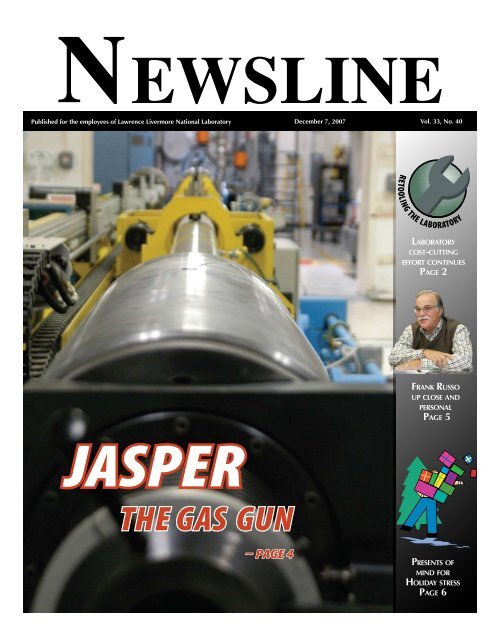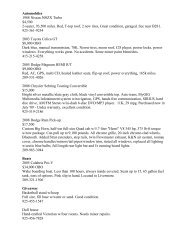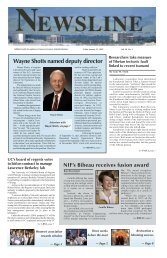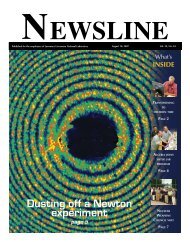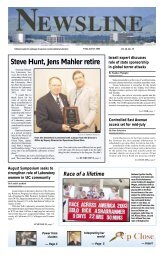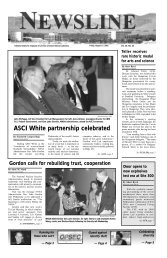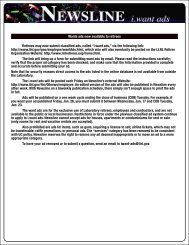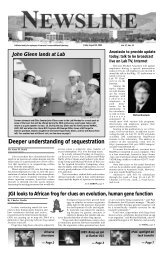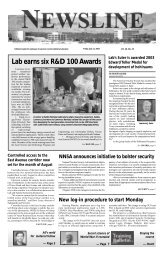NEWSLINE - Lawrence Livermore National Laboratory
NEWSLINE - Lawrence Livermore National Laboratory
NEWSLINE - Lawrence Livermore National Laboratory
Create successful ePaper yourself
Turn your PDF publications into a flip-book with our unique Google optimized e-Paper software.
Published for the employees of <strong>Lawrence</strong> <strong>Livermore</strong> <strong>National</strong> <strong>Laboratory</strong> December 7, 2007 Vol. 33, No. 40<br />
JasPeR<br />
THe gas gun<br />
– Page 4<br />
RETOOLING THE LABORATORY<br />
La b o r ato ry<br />
c o s t-c u t t i n g<br />
effort c o n t i n u e s<br />
Pag e 2<br />
fr a n k russo<br />
u P cLose a n d<br />
PersonaL<br />
Pag e 5<br />
Presents o f<br />
m i n d f o r<br />
Ho L i day stress<br />
Pag e 6
ANTICIPATED FLEX-TERM/SUPPLEMENTAL LABOR EMPLOYEE RESTRUCTURING TIMELINE<br />
2 <strong>NEWSLINE</strong><br />
December 7, 2007<br />
RETOOLING THE LABORATORY<br />
Section<br />
3161<br />
General Plan<br />
Finalized<br />
RETOOLING THE LABORATORY<br />
Section 3161<br />
Specic Plan<br />
Submitted<br />
to DOE/NNSA<br />
3161 plan moves ahead into final stage<br />
The <strong>Laboratory</strong>’s 3161 Specific<br />
Workforce Restructuring Plan is in<br />
the final stages of development and<br />
is expected to be submitted to DOE/<br />
NNSA in January 2008. A general<br />
plan was submitted in October and<br />
is on the Web at http://www.doeal.<br />
gov/WRLLNL/docs/DraftWorkforceRestructuringPlan.pdf<br />
The specific plan, designed to<br />
mitigate the effects of workforce<br />
restructuring on both employees<br />
and the community, will identify<br />
the career indefinite job categories that could be subject<br />
to both a Voluntary Self Select Option Program (VSSOP)<br />
and an involuntary program.<br />
However, Director George Miller still is assessing<br />
budget outlooks and employee attrition numbers to decide<br />
“... I will re-evaluate<br />
where we are in January<br />
2008 and make a decision<br />
regarding our career<br />
workforce at that time.”<br />
Flex-term and supplemental labor workforce restructuring<br />
efforts are continuing in an effort to effectively position<br />
the <strong>Laboratory</strong> and reduce operating expenses.<br />
Since Oct. 1, LLNL has reduced its supplemental<br />
(SL) and flex term (FX) workforce by 75 positions. It is<br />
expected that approximately 425 additional supplemental<br />
and flex positions will be eliminated by the end of January.<br />
Because these additional reductions exceed the require-<br />
Voluntary / Self-Select<br />
Announced for Career<br />
Indenite Workforce<br />
(if needed)<br />
DEC. 2007 EARLY JAN. 2008 JAN. 2008<br />
PRELIMINARY 3161 SPECIFIC PLAN TIMELINE<br />
whether a career indefinite employee<br />
workforce restructuring program will<br />
be needed and if the 3161 will be<br />
implemented.<br />
“We need to carefully look at our<br />
attrition, our current budget and the<br />
federal continuing resolution situation<br />
as well as the strides we’ve made<br />
to date on some of our cost-cutting<br />
initiatives,” Miller said. “We still are<br />
planning to submit our plan to LSO<br />
for their review, but I will re-evaluate<br />
where we are in January 2008 and<br />
make a decision regarding our career workforce at that<br />
time.”<br />
Should reductions affecting the Lab’s career indefi-<br />
– Director George Miller<br />
FEB. 2008 LATE FEB. 2008<br />
See UPDATE, page 8<br />
Flex-term and supplemental labor restructuring continues<br />
WARN<br />
Act<br />
Notication<br />
Flex-Term Employee<br />
Separation<br />
Notications<br />
Voluntary / Career<br />
Indenite Self-Select<br />
Separation<br />
(if needed)<br />
ments of the Federal WARN (Worker Adjustment and<br />
Retraining) process, all employees within the flex-term and<br />
supplemental job categories received notification letters in<br />
late November.<br />
The federal WARN Act and the California Labor Code<br />
See LABOR, page 8<br />
Supplemental Labor<br />
Employee<br />
Separation Notications<br />
Assess Need for<br />
Career Indenite<br />
Involuntary<br />
Separation<br />
Involuntary<br />
Career Indenite<br />
Separation<br />
(if needed)<br />
APRIL 2008<br />
Lab turns up the heat<br />
on energy conservation<br />
The heat is on for the <strong>Laboratory</strong><br />
to conserve energy. But in one<br />
directorate the heat is off; or at<br />
least a part of it. Employees within<br />
the Chemistry, Materials, Earth and<br />
Life Sciences (CMELS) directorate<br />
are turning in their electrical space<br />
heaters to help the Lab’s overall<br />
effort to lower its energy consumption.<br />
The directorate asked its employees<br />
to voluntarily turn in space<br />
heaters if they are no longer needed<br />
or wanted. The next day, Lori<br />
Souza, deputy associate director,<br />
said the directorate office’s walls<br />
were lined up with space heaters<br />
employees no longer wanted.<br />
“We’re trying to find an environmentally<br />
friendly way to discard<br />
these,” Souza said. “I tease people<br />
that I will bring them some warm<br />
socks.”<br />
The space heaters are just part<br />
of a bigger grass roots effort by<br />
the directorate to lower its energy<br />
WARN Act Flexible<br />
Workforce Separation<br />
Completed<br />
NOV. 17 JAN. 7, 2008<br />
JAN. 16, 2008<br />
JAN. 31, 2008<br />
See ENERGY, page 8<br />
ANTICIPATED FLEX-TERM/SUPPLEMENTAL LABOR EMPLOYEE RESTRUCTURING TIMELINE
December 7, 2007<br />
BEYOND<br />
TRANSITION<br />
UPDATES<br />
Employees subject to pay state SDI<br />
As a result of the contract transition from a public to private<br />
entity, employees became subject to paying California State Disability<br />
Insurance (CA SDI) as of Oct. 1. Due to CA SDI eligibility rules, most<br />
employees will not be entitled to full CA SDI benefits until approximately<br />
April 2008.<br />
LLNS recognized this gap and implemented a company-paid<br />
“bridge plan” that provides equivalent benefits to CA SDI until employees<br />
are fully eligible for the state plan. The plan also will provide<br />
a partial benefit to supplement CA SDI payments if an employee is not<br />
eligible for full benefits from the state.<br />
For out of state employees, the bridge plan will provide the basic<br />
$800/month benefit to replicate the UC benefit.<br />
In addition, employees will now be eligible for the paid family<br />
leave benefit that is part of CA SDI.<br />
For more information on CA SDI, refer to the Website at http://<br />
www.edd.ca.gov/fleclaimdi.htm.<br />
Post-retirement survivor benefit notice<br />
If you are an employee with a disabled dependent child or dependent<br />
parents, you may benefit from additional information regarding<br />
differences between TCPI and UCRP with respect to post-retirement<br />
survivor continuance benefits. Contact Ralph Howard, 3-6658, for<br />
additional information.<br />
Benefits Office has new customer hours<br />
Due to reduced staffing in the LLNL Benefits Office, and available<br />
self-service resources, effective Monday, Dec. 3, the Benefits<br />
Office telephone and walk-in customer service hours will be changed<br />
to 10 a.m. to 3 p.m., Monday-Friday.<br />
Benefits information and forms will continue to be available on<br />
the Benefits Office Website at https://benefits-int.llnl.gov/<br />
Fidelity representatives available<br />
Fidelity representatives will be available for a limited number<br />
of appointments on Dec. 11 and 19 for those employees who are<br />
interested in individual counseling on investment options and alternatives<br />
in the LLNS 401(k) Plan. To schedule an individual appointment<br />
with Fidelity, call 1-800-642-7131. For more information on<br />
your benefits, contact the Benefits Office, 2-9955, or on the Web at<br />
https://benefits-int.llnl.gov.<br />
<strong>NEWSLINE</strong> 3<br />
OR FACT?<br />
Editor’s note: Following transition to management under<br />
<strong>Lawrence</strong> <strong>Livermore</strong> <strong>National</strong> Security, LLC, several rumors have<br />
surfaced regarding the Lab’s policies and procedures. Newsline will<br />
use this space to address these issues regularly.<br />
Rumor: LLNS is using the <strong>Laboratory</strong>’s money to contribute $1 million<br />
to the HOME Campaign.<br />
Fact: LLNS recently announced it would match employee contributions to the<br />
HOME Campaign up to $ 1 million. This money comes directly from the fee LLNS<br />
receives to manage the Lab. It does not come out of the DOE budget to operate<br />
the Lab and its programs.<br />
Rumor: LLNS will decide who gets the donations and how much.<br />
Fact: LLNS will match employee contributions dollar for dollar up to $1 million.<br />
For example, an employee’s contribution of $100 to a charity of choice will be<br />
matched by LLNS contribution of $100 to that same charity. Should the HOME<br />
Campaign surpass the $1 million mark, the LLNS contributions will be prorated<br />
with employee contributions.<br />
Rumor: All custodians will be released from the <strong>Laboratory</strong> today (Friday,<br />
Dec . 7).<br />
Fact: There are no plans to release all custodians. As previously announced, flexterm<br />
and supplemental labor employees could be released in the future by the<br />
Lab’s workforce restructuring process, which is now under way. Employees who<br />
might be affected by this process would be notified by mid-January. As normal<br />
procedure, employees who have assignments ending as part of their regular fixed<br />
term contract also could be released after this date.<br />
Rumor: <strong>Laboratory</strong> employees will be forced to take vacation time if<br />
they want to be paid for the 2008 holidays.<br />
Fact: <strong>Laboratory</strong> employees will continue to receive the same paid holidays<br />
they received prior to the transition (see the Website at https://portal.llnl.<br />
gov/portal/page/portal/MYLLNL/ITEMS/DOCUMENTS/EMPLOYEE_CEN-<br />
TER/holidays.html). This confusion stems from the Nov. 30 Newsline listing<br />
of 2008 holidays, in which the headline incorrectly labeled the holidays as<br />
vacation.<br />
Rumor: LLNS will not be paying employees for jury duty.<br />
Fact: This is not correct. The policy has not changed. Employees who are<br />
called for jury duty will receive leave with pay for actual time on jury, per<br />
Lab policy.
4 <strong>NEWSLINE</strong><br />
December 7, 2007<br />
Science newS<br />
JASPER vital in plutonium equations of state<br />
By David Schwoegler<br />
Newsline staff writer<br />
In fiscal year 2007, the Joint Actinide Shock Physics Experimental Research<br />
(JASPER) team accomplished four plutonium (Pu) experiments that determine<br />
the final pressure, density and internal energy of Pu when compressed<br />
by a shock wave.<br />
In shock physics experiments, a curve known as the<br />
Hugoniot is a valuable tool for analyzing a material’s<br />
equation of state. If a material with a defined initial<br />
pressure, density and energy is subjected to a series of<br />
compression experiments of varying shock strengths, a<br />
set of new compression states can be plotted. The resulting<br />
curve is the material’s Hugoniot curve.<br />
“Every material has a unique Hugoniot curve. The<br />
Hugoniot can be determined absolutely through experiments<br />
that need to measure only distance and time —<br />
that is, velocity,” according to Lab physicist Neil Holmes,<br />
who is a JASPER project scientist.<br />
And, the JASPER team achieved four Hugoniot<br />
plutonium experiments just this year. Unique features of<br />
JASPER work include experiments that are performed<br />
on plutonium; that are successfully contained; and are<br />
highly accurate, with typical uncertainties less than 0.5<br />
percent. Recent installation of Photonic Doppler Velocimetry<br />
diagnostics extended Hugoniot experiment measurements<br />
to pressures much lower than those that could<br />
be measured before.<br />
JASPER researchers also performed test shots on<br />
surrogate materials to successfully validate new gun<br />
loading parameters, meeting three divergent goals:<br />
velocities down to two km/s with aluminum projectiles;<br />
low distortion and tilt of the projectile; and powder loads<br />
large enough to ensure post-shot sealing by the piston<br />
Photos by David Schwoegler<br />
On the cover and right: The<br />
Joint Actinide Shock Physics<br />
Experimental Research (JASPER)<br />
gas gun is located at the Nevada<br />
Test Site in Area 27.<br />
at the rear of the gun’s tapered section. This information is needed for pending<br />
experiments to complete the Hugoniot work.<br />
Operated as a “Radiological Facility” since 2001, midway through FY07,<br />
JASPER was re-evaluated by the <strong>National</strong> Nuclear Security Administration as a<br />
“Category 3 Nuclear Facility,” Holmes said. While a documented safety analysis<br />
is prepared to function within this newly assigned hazard category, Holmes<br />
said JASPER will continue to perform experiments through the end of 2008<br />
under a Justification for Continuing Operation. During that calendar year, the<br />
team plans to complete up to 18 experiments.<br />
JASPER’S centerpiece is a two-stage light gasgun,<br />
designed and operated by the <strong>Laboratory</strong> within<br />
Area 27 at the Nevada Test Site, 75 miles northwest<br />
of Las Vegas.<br />
It’s a nearly 100-foot, two-stage gas gun that can<br />
fire small projectiles at velocities of up to eight kilometers<br />
(five miles) per second — nearly 18,000 miles<br />
per hour — or more than 24 times the speed of sound.<br />
Since March 2001, JASPER has racked up 60 shots,<br />
including 15 in calendar year 2004.<br />
Built for $20 million inside existing facilities at<br />
NTS, the gun annually can fire up to 24 experiments<br />
and costs about $6 million to operate, with an expected<br />
10-year lifetime. In the absence of full-scale<br />
nuclear testing, JASPER helps assess the properties<br />
of nuclear weapon materials to verify that aging<br />
weapons can perform as designed.<br />
The team also performed an experiment that was<br />
part of the Nuclear Counter-Terrorism Design Support<br />
effort.<br />
The control room for the JASPER gas gun.
December 7, 2007<br />
A conversation with...<br />
FRANK RUSSO<br />
(Editor’s note: The transition to management by <strong>Lawrence</strong> <strong>Livermore</strong> <strong>National</strong> Security<br />
has brought the Lab a few new faces among its senior leaders. Newsline features “A<br />
Conversation with…” a series of profiles on the <strong>Laboratory</strong>’s new leadership. This week,<br />
meet Frarnk Russo.)<br />
Frank Russo is the principal associate director for Operations and Business, which includes<br />
four directorates: Strategic Human Capital Management, Business, Facilities and<br />
Infrastructure, and Nuclear Operations. Supporting these directorates are the functions of<br />
Staff Relations, Functional Operations, Institutional Facilities Planning and Management,<br />
Operations and LLNS/LANS Integration.<br />
Prior to joining the <strong>Laboratory</strong>, Russo served as Bechtel principal vice president. He<br />
has 34 years of operations and business experience, beginning his Bechtel career in 1973 in<br />
procurement, supporting 10 international and domestic nuclear projects.<br />
During his career, he served as president and general manager of the Advanced Mixed<br />
Waste Treatment Plant at Idaho <strong>National</strong> <strong>Laboratory</strong>. From 2001 to 2005, he was general<br />
manager of the Idaho Completion Project and director of program management for Bechtel<br />
BWXT.<br />
Russo is a Certified Project Management Institute instructor and Six Sigma champion.<br />
He has trained 2,500 Department of Energy and Nuclear Weapons Complex site personnel<br />
on DOE Order 413.3.<br />
He has bachelor’s degrees in political science and history from Pace University and<br />
attended Stanford University’s Executive Management Program.<br />
What did you want to be when you were a kid: I’m still trying to figure that out. Seriously, I never<br />
had any aspirations to be something like an astronaut, for instance. But, one thing I always knew was<br />
that I wanted to work with people. I am most effective working in teams.<br />
First job: My family was in the construction business, so I spent many summers, from age 13 up,<br />
working at New York City construction sites. I started out filling water buckets. It was hard work in the<br />
summer. And, I felt like I had to work even harder than other employees since I was related to the guy in<br />
charge. The hard work served to motivate me through college: Any doubts I had about the importance<br />
of education ended during my sophomore year when my father decided that I didn’t need a Christmas<br />
break and that I needed to come work with him. He put me on the 85th floor of a building in the bitter<br />
cold and wind of winter.<br />
Guiding principle: Integrity. Honesty. Treat people with intelligence because of who they are. And,<br />
one very important principle: Never sugar coat the facts. Be truthful.<br />
Work philosophy: Work smart, there is an elegant solution to many things. Work smart, the way a<br />
lot of people at this Lab do, and you will be successful.<br />
Best decision: Marrying my wife, Maryann, 35 years ago. We’ve moved 21 times due to my career.<br />
She is the underlying force in our success.<br />
Worst decision: Being a positive person, I can’t say I’ve made any worst decisions. However, there<br />
was one bad situation I can think of. One of my transfers took us to Maryland and it was there that my<br />
son contracted Lyme disease. I wish we had never gone there.<br />
Ph o t o s b y<br />
bo b hi r s c h f e l d/Ne w s l i N e<br />
<strong>NEWSLINE</strong> 5<br />
Career highlight: In<br />
Canada, I managed a 12<br />
million man-hour job<br />
without any lost-time accidents.<br />
That is something<br />
I will never forget and always<br />
be proud of.<br />
Career low point: I<br />
was assigned to a refinery<br />
project that was 60 percent<br />
complete and 95 percent spent (budget) and the situation was not fixable. I came in too late and the job<br />
was not emotionally rewarding. I learned that sometimes you just can’t change the way things are.<br />
Word or phrase that best describes you: At Bechtel, there is a leadership program called “Collegial<br />
Role Counseling.” It involves intensive interactions where you rate yourself and are rated by others.<br />
There is an activity called “What kind of vehicle are you?” where, based on your characteristics, you are<br />
compared to a type of car by your peers. Being of Italian decent, I naturally thought those critiquing me<br />
would say I was an Italian sports car. Much to my surprise, they said I was an ice cream truck because:<br />
“they could hear me coming, they were always happy to see me and I had a flavor for everyone.”<br />
Interests/hobbies: Snow skiing, hiking and traveling.<br />
Favorite book: “Atlas Shrugged,” by Ayn Rand. I read it in college and it really changed my life. The<br />
book taught me a lot about people and how motivators are perceived and treated in society.<br />
What actor would play you in a movie: Al Pacino – intense and passionate (but not in the<br />
“Godfather”).<br />
Favorite food: Anything Italian and anything Asian.<br />
Pet peeves: People who say they can do something and they can’t. People who say they understand<br />
and you find out they don’t. My motto is: be honest up front and don’t lead me astray — if you need<br />
help, we can find it.<br />
Person you’d most like to meet: I would have liked to have met President Ronald Reagan. He used<br />
everything he had plus people and their skills to make tremendous contributions to our country.<br />
Best vacation ever: Any vacation that involved skiing. Also, a cruise my wife and I took on our 30th<br />
wedding anniversary. It was the first time in my career that I took a two-week vacation.<br />
Next career goal: I am in it. It is helping us through this (the transition).<br />
How do you deal with stress: Exercise.<br />
Characteristic you most and least admire in people: Most: Honesty, integrity, a concern for<br />
people; and communicating face-to-face, not just by e-mail or phone. Least: Hidden agendas of people;<br />
duplicity; the “me” generation.<br />
Best piece of advice you’ve received: As the saying goes: “Keep your friends close and your enemies<br />
closer.” You can learn more and grow more by understanding the people who don’t always agree<br />
with you.<br />
Next milestone I plan to complete my career right here in <strong>Livermore</strong>. That is my goal. This is going to<br />
be my last assignment. And, after so many moves, my wife and I are in definite agreement.
6 <strong>NEWSLINE</strong><br />
December 7, 2007<br />
Holiday safety tips<br />
Safety is a top priority at the <strong>Laboratory</strong>, and during this<br />
holiday season employees are urged to take safety home with<br />
them. Many of our traditional holiday activities pose safety<br />
concerns.<br />
• Fire is perhaps the greatest hazard. Make sure your fireplace<br />
or wood stove are operating safely. Don’t burn wrapping paper<br />
because it often contains metallic materials that can be toxic.<br />
Don’t burn evergreens or wreaths either, since they’re likely to<br />
flare out of control and send flames and smoke into the room.<br />
never use lighted candles near trees, boughs, curtains or with<br />
any potentially flammable item, and never leave candles or a<br />
fireplace burning unattended or when you go to sleep. Be sure<br />
your smoke detectors are in good working order, and consider<br />
installing a carbon monoxide detector as well.<br />
• If your holiday traditions include a Christmas tree, be sure<br />
to keep it well watered and remove it from the house when it<br />
dries out. Christmas trees account for hundreds of fires each<br />
year. The video at http://www.fire.nist.gov/tree_fire.htm shows<br />
just how fast a dry tree ignites.<br />
• Use care when hanging lights or decorations, inside and<br />
out. The same techniques for power tool and ladder safety that<br />
we follow at work should be used at home as well.<br />
• In addition, a number of holiday plants are poisonous,<br />
including mistletoe, holly berries, Jerusalem cherry, amaryllis<br />
and poinsettia. Keep all of these plants out of children’s reach<br />
and away from pets.<br />
• Holiday food and parties also are fraught with safety issues.<br />
if you’re cooking, wash your hands, utensils, sink and anything<br />
else that comes in contact with raw poultry, and refrigerate<br />
or freeze leftovers within two hours of cooking. If you’re<br />
entertaining, remember that an increasing number of people are<br />
dangerously allergic to peanuts and crustaceans (e.g., shrimp,<br />
crab, lobster). Technical note: shellfish and crustaceans are<br />
not synonymous — shellfish are clams, mussels, scallops and<br />
other sea-beasties in hard shells; people allergic to crustaceans<br />
usually have no problem with shellfish.<br />
• Both hosts and partygoers should be sensible about alcohol<br />
consumption. More than half of all traffic fatalities are alcoholrelated.<br />
Don’t let people drink and drive. Use designated drivers<br />
or taxis to get guests safely home after a holiday party. And<br />
watch out for fatigue — you may not have imbibed the eggnog,<br />
but your driving may be severely impaired if you are tired from<br />
too many late nights or sleepy from too much rich food.<br />
The holidays can be a wonderful time, full of good cheer<br />
and delight. Keep safety in mind so that you and your family,<br />
friends and guests have a merry, safe and healthy time.<br />
Newsline want ads temporarily unavailable<br />
Due to technical issues, the want ads will not appear<br />
in today’s edition of Newsline. In addition, the want ads<br />
Website is temporarily unavailable.<br />
More information and updates on the want ads system<br />
upgrade will be provided in future editions of NewsOnLine<br />
and Newsline.<br />
Tips for managing a season of<br />
stress and future uncertainty<br />
<strong>Laboratory</strong> employees are in the midst of a period of major change, uncertainty — and stress.<br />
Compounding the stress of the contract transition, employees also are experiencing additional<br />
change and uncertainty due to workforce restructuring and realignments of responsibility. And the<br />
holiday season adds even more stress.<br />
“Chronic or poorly managed stress can jeopardize our health, our relationships, and our general<br />
well-being,” said Kay Gorsuch of Health Services’ Employee Assistance Program. “Everybody<br />
handles and responds to stress in their own unique ways. Some people become super-organized and<br />
driven. Others withdraw or become depressed. Others find themselves short-tempered and rattled<br />
by things they previously took in stride. Sometimes they react one way and then another.”<br />
According to Gorsuch, signs that someone is having trouble managing stress include significant<br />
changes in eating or sleeping habits, headaches and stomach pain, muscle tension and pain,<br />
irritability or temper outbursts, withdrawal and isolation, difficulties concentrating or making decisions,<br />
and significant changes in mood or attitudes from what is “typical.”<br />
Unfortunately, stress is to modern life what precipitation is to the rain forest — inevitable. The<br />
key to coping, during the holidays and throughout the year, is finding effective ways for managing<br />
stress. Among the coping techniques health professionals recommend are the following:<br />
• Choose your reaction. You can’t control outside events or the behavior of others, but you<br />
can choose how you react to them.<br />
• Choose health. Eat nutritious meals, go easy on the alcohol and get plenty of exercise and<br />
sleep.<br />
• Plan ahead. Spread out your holiday activities and allow for the inevitable delays when<br />
driving, shopping or running errands.<br />
• Use your support networks. Take advantage of friends, family, church or other social networks<br />
to stay connected.<br />
• Say “no.” It’s okay to decline invitations, opt out of gift exchanges or cut back on decorating,<br />
cooking and entertaining.<br />
• Remember the spiritual. Take time to renew your spirits, whether by attending worship,<br />
meditating, reading inspirational literature, talking with upbeat people or simply going for a walk in<br />
the woods.<br />
• Reach out. Get involved in helping others through a community soup kitchen, senior center,<br />
children’s hospital or other worthy cause.<br />
Gorsuch reminds employees that the <strong>Laboratory</strong> offers a number of resources to help them<br />
manage stress:<br />
• The Work-Life Center offers educational and supportive wellness, eldercare, parenting, and<br />
diversity programs as well as services in addition to referrals and resources. Contact the Work-Life<br />
Center at 2-9543 or wellness@llnl.gov.<br />
• The (internal) Employee Assistance Program (EAP) offers confidential short-term counseling<br />
and management consultations. Call 3-6609 for an appointment or for more information.<br />
• Concern EAP (external) has work-life programs, including financial and career counseling,<br />
as well as confidential short-term counseling. You can contact them at 1-800-344-4222.<br />
• The Healthy Heart program (https://healthservices-int.llnl.gov/php/healthy_heart.php) offers<br />
physical and stress assessments as well as healthy lifestyle coaching.<br />
• The Lab’s Ombuds Program (https://ombuds.llnl.gov/index.html) is a peer program that<br />
provides a forum for discussing work-related issues and concerns in a neutral and confidential manner.<br />
• The Lab’s Crisis Action Team (CAT) is available if concerns arise regarding possible workplace<br />
violence. The primary CAT contact is Bob Perko of Staff Relations at 2-9501.<br />
• The <strong>Livermore</strong> <strong>Laboratory</strong> Employee Services Association (LLESA) is a resource for<br />
exercise classes and networking groups. See the Website at https://llesa.llnl.gov/ or call the LLESA<br />
office at 2-9402.<br />
• Last but not least, your supervisor can work with you to develop strategies for prioritizing<br />
workplace demands.<br />
The Health Services Web page on stress management (https://healthservicesint.llnl.gov/php/health_resources/articles/stress_management.php)<br />
provides additional<br />
information about handling stress, including Lab videos and<br />
books and articles for further reading.<br />
Assistance also is available through employees’ healthcare<br />
providers.<br />
“Stress is an unavoidable part of life,” Gorsuch said.<br />
“However, when it is chronic or someone has difficulty<br />
managing the stress, problems arise. It’s important to be<br />
proactive in making changes for yourself or helping coworkers<br />
know about the resources available before stress<br />
becomes disruptive at work or home.”
December 7, 2007<br />
RETIREE’S CORNER<br />
Jan and Harold Pfeifer (EPD,<br />
1993) recently returned from a trip<br />
(September 2007) to the Republic<br />
of Ireland. Briefly, the weather<br />
was sunny, temperatures in the<br />
low 70s, scenic country sides and<br />
friendly Irish people. They journeyed<br />
to Eire in search of a leprechaun<br />
with his pot of gold.<br />
They were on a Collette bus<br />
tour which started in Limerick. A<br />
castle highlight was an evening<br />
medieval banquet with food, music<br />
and entertainment. They visited<br />
a working dairy farm and took a<br />
city tour of Galway. They traveled<br />
to Blarney Castle and to the city<br />
of Waterford, where they toured<br />
the Waterford Crystal Factory to<br />
see many beautiful objects and<br />
how they are made. They stayed at<br />
Cabra Castle, which had been renovated<br />
with many new furnishings.<br />
They truly enjoyed the surroundings,<br />
visiting with other travelers<br />
and the food. On to Dublin where<br />
the action is churches, castles,<br />
forts, museums, pubs, shopping<br />
and more. Their accommodations,<br />
tours, Irish coffee, Guinness ales<br />
and sightseeing were superb. They<br />
highly recommend a trip to Ireland.<br />
(See the retiree’s Website for<br />
the unedited version).<br />
Ann Parker (Technical Information<br />
Department 2007) received<br />
the 2007 Colorado Book Award for<br />
Popular Fiction for her novel “Iron<br />
Ties,” the second in her silver<br />
in MeMORiAM<br />
William Clair Mumper, a Lab<br />
retiree and security escort, died after<br />
a brief illness Nov. 23, at Kaiser Permanente<br />
Hospital in Walnut Creek.<br />
He was 81.<br />
Born in Turk Creek, Pa.,<br />
Mumper joined the U.S. Navy at 18<br />
and went on to serve in World War<br />
II and the Korean conflict. Before<br />
his honorable discharge in 1955,<br />
Mumper earned his pilot’s license,<br />
as well as certificates in business<br />
administration and as a radio technician.<br />
He worked for 27 years as a<br />
senior scientific associate at LLNL,<br />
and then remained as a consultant<br />
for three more years. Until the time<br />
of his death, he remained at the Lab<br />
working as a security escort.<br />
William Clair Mumper<br />
rush historical mystery series. The<br />
Colorado Book Awards are presented<br />
by the Colorado Center for<br />
the Book program of the Colorado<br />
Humanities. Ann’s series is set in<br />
Leadville, Colo., during the silver<br />
rush of the late 1870s and early<br />
1880s. For information about her<br />
books, Leadville history and more,<br />
visit her Website at http://www.<br />
annparker.net.<br />
Arlene and Stephen Chin<br />
will kick off the year for the travel<br />
group with a program entitled<br />
“Circling Iceland.” It will be held<br />
Jan. 22 at 2 p.m. in the <strong>Livermore</strong><br />
Police Department Community<br />
Room, 1110 S. <strong>Livermore</strong> Ave.<br />
Don’t forget to send in the<br />
retirees association application and<br />
ballot, which should have arrived<br />
in the mailboxes of existing members<br />
and can be looked up online<br />
at llnlretirees.org. The first 2008<br />
luncheon will be Jan. 16, topic<br />
TBD. And mark you calendars for<br />
the dinner dance Feb. 9.<br />
Margy O’Dell is looking for<br />
people to share their travel experiences<br />
with the travel group.<br />
Contact her at 925-449-7262 or via<br />
e-mail at mardon4308@comcast.<br />
net.<br />
Merry Christmas and Happy<br />
New Year. Please send input to<br />
Gus and Jane Olson. E-Mail: AugustO@aol.com<br />
or JaneRubert@<br />
aol.com. Snail mail address: 493<br />
Joyce St., <strong>Livermore</strong>, CA 94550.<br />
Mumper and his wife made their<br />
homes in Hayward, <strong>Livermore</strong> and<br />
then concurrently in Modesto and<br />
Mesa, Ariz, before finally returning<br />
to <strong>Livermore</strong> in 1996.<br />
A former member of both the<br />
Elks and E Clampus Vitus, he was<br />
a current member of the Sons In<br />
Retirement (SIRS) and served as<br />
treasurer of his local homeowner’s<br />
association. He enjoyed his weekly<br />
pinochle games.<br />
Mumper was preceded in death<br />
by two sons, Newton Clair and James<br />
Alan Mumper. He is survived by<br />
his wife of 56 years, Marion, three<br />
remaining children, Melanie, William<br />
Jr. and Matthew, and eight grandchildren.<br />
PeOPLe newS<br />
<strong>NEWSLINE</strong><br />
newsline is published weekly by the Public Affairs<br />
Office, <strong>Lawrence</strong> <strong>Livermore</strong> <strong>National</strong> <strong>Laboratory</strong><br />
(LLnL), for <strong>Laboratory</strong> employees and retirees.<br />
Public Affairs Office: L-797 (Trailer 6527), LLnL,<br />
P.O. Box 808,<br />
<strong>Livermore</strong>, cA 94551-0808<br />
Telephone: (925) 422-4599; Fax: (925) 422-9291<br />
e-mail: newsline@llnl.gov or newsonline@llnl.gov<br />
Web site: http://www.llnl.gov/pao/<br />
Distribution: Mail Services at LLnL<br />
<strong>NEWSLINE</strong> 7<br />
HELPING OTHERS MORE EFFECTIVELY<br />
HOME contribution deadline is Dec. 14<br />
There is still time to be part of the 2007 HOME Campaign. Employees<br />
can contribute through Friday, Dec. 14. In addition, Friday,<br />
Dec. 7 is the last day employees can make onetime contributions. To<br />
make your online contribution or download a pledge form, go to the<br />
HOME Website at https://home.llnl.gov/<br />
LLNS donates $1 million to match contributions<br />
<strong>Lawrence</strong> <strong>Livermore</strong> <strong>National</strong> Security, LLC (LLNS) will donate<br />
$1 million of its annual fee for managing the Lab to match HOME<br />
Campaign contributions from <strong>Laboratory</strong> employees.<br />
The donation will benefit community/nonprofit agencies in the Tri<br />
Valley, San Joaquin Valley and Greater Bay Area. The money comes<br />
directly from the LLNS fee; it does not come out of the DOE budget to<br />
operate the <strong>Laboratory</strong>.<br />
The LLNS Board of Governors recently approved the matching<br />
donation of up to $1 million. For each dollar an employee donates to his<br />
or her charity of choice, LLNS will match that dollar to that particular<br />
charity. Should the campaign raise more than $1 million, LLNS will<br />
prorate the matching fee.<br />
All LLNS matching donations will be completed by the end of the<br />
year, regardless of whether the employee makes a onetime donation or<br />
chooses a bi-weekly deduction.<br />
The HOME Campaign is one of the Tri Valley’s most generous annual<br />
charity drives, and is a major community support activity for the<br />
<strong>Laboratory</strong>. Through the campaign, Lab employees<br />
donate money via payroll deduction<br />
or onetime donations to benefit more than<br />
400 local agencies of their choice, including<br />
umbrella agencies such as the United Way<br />
and Tri Valley Community Fund. Last year,<br />
the campaign raised more than $1.4 million.<br />
This year’s campaign will close on Dec. 14.<br />
To date the campaign has raised approximately<br />
$850,000.<br />
For more information on LLNS matching<br />
funds, see the press release. To donate to<br />
the HOME Campaign, go to the Web.<br />
William Thomas “Tom” Reece<br />
William Thomas “Tom” Reece died<br />
Nov. 30, after a year-long battle with<br />
cancer.<br />
He worked at the Lab for 38 years as<br />
a senior engineering associate in Materials<br />
Management. He was involved in the<br />
weapons testing at the Nevada Test Site and<br />
laser groups.<br />
Reece was a resident of Clayton and a<br />
former resident of <strong>Livermore</strong>.<br />
He is survived by his wife of 13 years,<br />
Bonnie Carpenter-Reece; his children,<br />
Steve Reece, Dave Reece and Mary Ann<br />
Holman, Annette Carpenter, Pat Hurst-<br />
Alger and Laura Cook; 13 grandchildren;<br />
five great-grandchildren and many nieces,<br />
nephews, cousins and friends.<br />
A memorial service will be held at<br />
11 a.m. Saturday, Dec. 8, at Cornerstone<br />
Fellowship, 348 N. Canyons Parkway,<br />
<strong>Livermore</strong>. Friends and family are invited<br />
to attend. In lieu of flowers, donations may<br />
be made to the Salvation Army in Reece’s<br />
memory.<br />
Newsline editor: Don Johnston, 3-4902<br />
Contributing writers: Nancy Garcia, 2-1099; Bob<br />
Hirschfeld, 2-2379; Linda Lucchetti, 2-5815; David<br />
Schwoegler, 2-6900; Anne M. Stark, 2-9799;<br />
Stephen wampler, 3-3107.<br />
Photographer: Jacqueline McBride, 2-0175<br />
Designers: Julie Korhummel, 2-9709;<br />
Kathleen Smith, 3-4769<br />
For an extended list of Lab beats and contacts, see<br />
http://www.llnl.gov/pao/contact/
8 <strong>NEWSLINE</strong><br />
December 7, 2007<br />
ENERGY, from page 2<br />
costs. Last week the <strong>Laboratory</strong> announced it must<br />
reduce overall energy consumption by 9 percent.<br />
In coming months various programs will be<br />
introduced to meet that goal, but for now the Lab is<br />
appealing to all to take some simple steps.<br />
In October the CMELS directorate began its<br />
push to remind employees to turn off office lights<br />
when leaving, shut down printers and copiers, and<br />
when possible, turn off some computers (keeping in<br />
mind some computers need to remain on in order to<br />
be backed up).<br />
The directorate will lower its office thermostats<br />
UPDATE, from page 2<br />
nite population be necessary, a self-select option<br />
would be offered first. In this process, <strong>Laboratory</strong><br />
senior managers would evaluate their workforce and<br />
determine which populations would be eligible and<br />
which would be ineligible or excluded from participating.<br />
“Not all employees and not all work groups<br />
will be included in a voluntary or involuntary plan,”<br />
said Bruce Warner, Associate Director at Large.<br />
LABOR, from page 2<br />
require employers to provide 60 days advance notice<br />
of an anticipated release of 50 or more individuals<br />
within a rolling 30-day period. The WARN notification<br />
period began Nov. 17 and concludes Jan. 17.<br />
The <strong>Laboratory</strong> employs approximately 2,000<br />
flexible workforce employees, 1,150 as flex-term and<br />
about 650 as supplemental labor provided by IAP Inc.<br />
The balance is in other employment categories that<br />
are not subject to these reductions – such as students.<br />
The approximately 500 positions that are being eliminated<br />
come from the flex-term and supplemental<br />
labor population.<br />
“All employees within these employment<br />
groups received formal letters as part of the<br />
Lab’s workforce notification process,” said<br />
Tammy Jernigan, associate director for Strategic<br />
Human Capital Management. “We currently are<br />
identifying the positions affected and the employees<br />
who will be ending their assignments.<br />
We plan to inform these flex-term employees<br />
in early January. This is a difficult process for<br />
all of us, but one that is necessary to effectively<br />
position the <strong>Laboratory</strong> strategically for the<br />
future.”<br />
a degree or two during the winter.<br />
“Generally people are doing all they can to help<br />
out,” Souza said. “These are not sacrifices we are<br />
making, just common sense things that save energy.”<br />
Eliminating space heaters is one of many ways<br />
Lab employees can save energy.<br />
While space heaters offer additional heat in<br />
otherwise drafty buildings, they consume additional<br />
electrical energy, may overload electrical systems<br />
and pose a fire hazard when not used properly.<br />
Most space heaters use 750 to 1,500 watts of<br />
electricity, reducing electrical capability in many<br />
buildings. In some instances usage of space heaters<br />
may reach 10 times the electrical load of lighting, or<br />
“We have a large number of employees with critical<br />
skills that must be maintained in order for us to effectively<br />
serve the nation and meet critical mission<br />
requirements.”<br />
The <strong>Laboratory</strong> last offered a voluntary separation<br />
incentive plan to employees in 1996. Approximately<br />
600 career indefinite employees participated<br />
in that program, negating the need for an involuntary<br />
program. Warner noted that should a decision<br />
be made to implement the 3161 plan for the career<br />
indefinite workforce that it would not include an<br />
Flex-term employee notifications will begin<br />
Jan. 7. IAP will notify their affected employees<br />
by Jan. 16 with an expected Jan 18 departure.<br />
(see timeline, page 2).<br />
Strategic Human Capital Management has<br />
developed a number of internal and external<br />
services that will be available to all employees<br />
affected by the restructuring process.<br />
“We want to do as much as we can to help<br />
employees with this transition,” said Art Wong,<br />
head of Strategic Recruiting and Development.<br />
“We have developed a special Website<br />
with career ideas and links to resources: https://<br />
careerstrategies-dev.llnl.gov/ for employees and<br />
we are partnering with IAP and local county and<br />
state resources to coordinate a job fair.”<br />
IAP also has developed a Web page to assist<br />
employees. The “Placement Assistance Site”<br />
lists companies and positions available in the<br />
Tri-Valley areas as well as throughout the state.<br />
A centralized exit process also is being developed.<br />
After notification, flex term employees<br />
will be able to coordinate with such organizations<br />
as HR, payroll, property, ESH&Q, Security<br />
and cyber-security. IAP will have a similar<br />
centralized process.<br />
Joining the ranks<br />
The Security Organization’s Protective Force Division<br />
Training Group graduated eight new Security Police Officers<br />
last Friday.<br />
The candidates’ basic security police officer training<br />
academy began Sept. 4 and was completed with their<br />
swearing-in.<br />
The Protective Force Division Operations also recognized<br />
those security police officers who had been promoted in<br />
recent months. The group included one lieutenant and five<br />
sergeants.<br />
dav i d sc h w o e g l e r/Ne w s l i N e<br />
even office computer systems, said Blair Horst, of<br />
Plant Engineering.<br />
If 1,000 people stopped using space heaters,<br />
they could save approximately $30,000 in energy<br />
costs. The removal of 14 space heaters is enough to<br />
power the average US home for a full year.<br />
However, Horst is quick to add that people are<br />
not required to give up their heaters. Those who<br />
need the space heaters should try to run them at the<br />
lower or middle settings, rather than full blast, to<br />
save on energy (for example a 1,500 watt heater set<br />
to medium uses only 1,000 watts of electricity; set<br />
to low it uses 750 watts). When leaving an office or<br />
building, heaters should be turned off.<br />
enhanced incentive as in 1996. “We’ve gotten guidance<br />
from NNSA that they will approve the current<br />
LLNL separation package that includes one week of<br />
pay per year of service up to 26 weeks and phased<br />
health coverage,” he said.<br />
Should a decision be made to implement a<br />
voluntary career-indefinite separation program, the<br />
terminations are forecast to be completed by the end of<br />
February. If an involuntary program for career indefinite<br />
employees is necessary, separations are forecast to<br />
be completed by April 2008 (see timeline, page 2).<br />
PRSRT STD<br />
U.S. POSTAGE<br />
PAID<br />
LIVERMORE, CA<br />
PERMIT NO. 154<br />
newsline<br />
LLnL<br />
PO Box 808, L-797<br />
<strong>Livermore</strong>, cA 94551-0808


